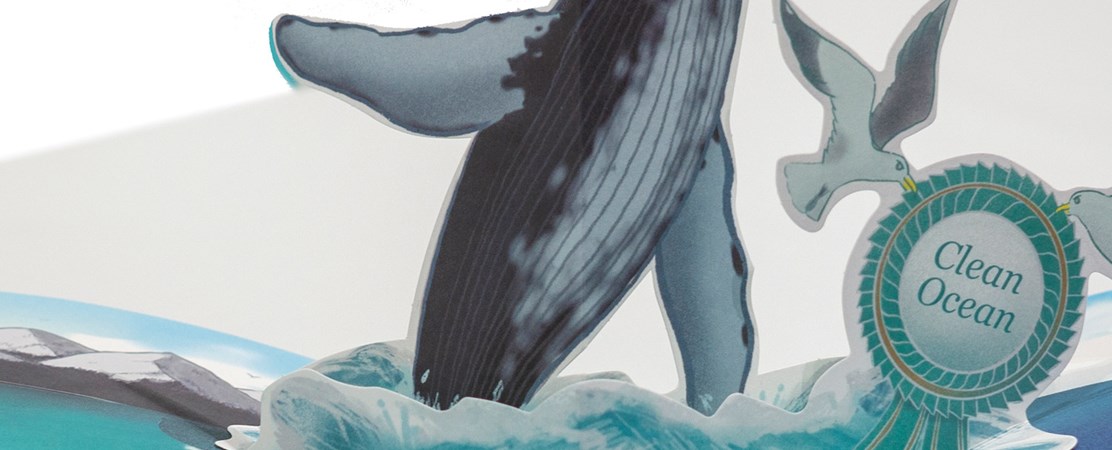Our Plastic Ocean, Our Clean Ocean

By Herminia Din, Professor of Art Education, University of Alaska Anchorage
Along with the air we breathe, the ocean is the most necessary element required to sustain life on our planet.
It was soon after I moved to Alaska to take a position at the University of Alaska Anchorage (UAA) that I had a chance to fly over the Bering Sea between the United States and Russia. It supports some of the richest biological populations of mammals and fish, and it took my breath away. But little did I know that many years later I would become part of a team of art educators with a passion to address the emerging problem of plastics pollution in this and other areas of the Arctic, and the world. This would lead to the creation of a novel pop-up booklet to bring the ocean into the classroom.
UAA Art Department is one of twenty founding members of the UArctic Thematic Network on Arctic Sustainable Arts & Design (ASAD), and we have long collaborated across the region on different projects. Inspired by Gyre: The Plastic Ocean exhibit at the Anchorage Museum, in 2014 my colleagues from Nord University and I formed a new research collaboration to develop teaching and learning materials addressing plastic pollution in our respective environments.
We began to research the problem and develop workshop materials for K-6 teachers and students. In 2016, I took advantage of my sabbatical leave to join my Norwegian colleagues for three teacher-training workshops in Lurøy, Nesna, and Brønnøysund. Subsequently, we received numerous requests from other schools and communities for the same workshops in their regions. To best meet the demand, we began to conceptualize the type of tool we could develop. Keeping the target age group in mind, we concluded that a storybook approach was ideal to engage students in a participatory and hands-on learning experience.
In 2018, I worked with the Kenai Peninsula Borough School District in Alaska to organize hands-on workshops using art and science-integrated methods to study plastic pollution in Alaska. We visited two village schools in Port Graham and Nanwalek, and held 14 workshop sessions with a total of 95 students ranging from kindergarten to 12th grade. During each workshop, we discussed current issues on the plastic pollution in our oceans, and students learned how to make either a pop-up card or a small pop-up book to express their concerns.
Later that fall, I landed on St. Paul Island in the middle of the Bering Sea. I was there to collaborate with the Aleut Community during their annual Bering Sea Days and lead a week-long art workshop focusing on plastic pollution. St. Paul Island is small; it has a total area of 295 square miles of which 40 square miles is land and 255 square miles is water. The population is approximately 480 people, over 100,000 northern fur seals, and more than 280 species of birds and seabirds. There are also other marine and land mammals on the island, including harbor seals, sea lions, walrus, whales, reindeer, fox, and shrew.
On field trips to different beaches during the week, I was stunned to witness the large amounts of plastic waste washed up on shore. Fishing nets, ropes, containers, bottles. This was a sobering view, considering we were on a very small remote island, far away from major populated areas. At the end of the week, working with more than 40 students from kindergarten to middle school, we co-created a large-scale art installation titled Our Plastic Ocean vs. Our Happy Ocean.
After three years of research and gathering first-hand information about plastic pollution in the Arctic, in August 2019 we finally published Our Plastic Ocean, Our Clean Ocean, an interactive pop-up book. The book explains to young readers not only how our ocean pollution problem came to be, but also why we must find solutions as quickly as possible. It also shows them what they can do right now to be part of those solutions. In part 1, “Our Plastic Ocean: What’s Wrong and How We Can Fix It”, the illustrations and pop-ups make clear the connection between a polluting act and the widespread harm it causes. In part 2, “Our Clean Ocean: How We Can Keep It Clean for All of Us”, the reader learns ways to reduce pollution and keep the ocean clean and healthy. The reader’s guide outlines simple steps we can take in our own daily life for reducing sources of ocean pollution. It seeks to inspire readers to use their own artistic talents to express the adverse impact our contemporary culture of consumption wreaks upon the ocean and our entire natural environment.
Conventional wisdom might indicate the Arctic would be immune from the excesses of modern society. Sadly, images of pristine waters and untouched coastlines could not be more false. From St. Paul Island, Alaska to the beaches of northern Norway, plastic waste or marine debris can be seen washed up on shorelines and floating offshore. Present and future generations have a responsibility to recognize this global crisis and take small but significant steps to make a difference.
Art is a universal medium that can serve as a catalyst to build an understanding of difficult issues. This project represents a true collaborative effort among the ASAD network members to identify and share innovative practices in teaching, learning, research, and to enhance knowledge of the North.
